
SECTARIAN VIOLENCE IN HANGU:
GENESIS, FACTORS AND REMEDIES
Abdul Rauf* Farmanullah**
Abstract
The menace of sectarianism, like other sectarian-ridden zones in the other provinces of Pakistan, is also spreading in some parts of Khyber Pakhtunkhwa. Hangu has had a history of sectarian violence that has struck the city five times since 1980. The sectarian hatred has divided the people of Hangu which has considerably damaged the social and political harmony of the district. Many valuable lives and properties of worthy in millions have been lost in sectarian clashes. If it is not checked and addressed properly may spill over to the other parts of Khyber Pakhtunkhwa which are free or less affected from religious ecclesiastical sectarianism. In the following paper an attempt has been made to diagnose the cause of the malaise and suggest certain remedies to curtain this problem. The issue of sectarianism is first looked in available published literature followed by a field work in district Hangu.
Introduction
In recent years, religious intolerance and bigotry has reached deep inside our society. There is less tolerance and respect for other’s views and opinions among the people. The followers of a sect consider themselves as ‘true Muslims’ and others as ‘infidels’. Innocent worshipers are targeted in mosques and Imam Bārgāhs in the name of religion. The narrow interpretation of Islam and Jihād by semi-literate mullahs has damaged the true image of Islam.
Shia-Sunni differences have its roots in the election of the successor of the Prophet (PBUH). Shia claimed Ali, a companion and cousin of the holy Prophet, as successor on the basis of a pronouncement of the Prophet at Ghadir while the Sunni believes that not designating any successor by the Prophet means the matter is left to the community. The political/personality dispute between Shia and Sunni transform into religious and transmitted to next generations which sometime converted to clashes between these two Muslim communities.
The menace of sectarianism is not new to Pakistan. Even before the creation of Pakistan, sectarian clashes used to happen off and on in Indo-Pakistan subcontinent. After the formation of Pakistan, there was harmony between Shi’as and Sunnīs to some extent. However, the ‘divide and rule’ policy adopted by Zia ul Haq and Iranian Revolution compounded the already existed sectarian divide. Other major developments that led to sectarian divide were Saur Revolution and the subsequent Soviet Union intervention in Afghanistan, the emergence of Jihādī and militant organisations, Iranian Revolution and Iran-Iraq war. For an objective comprehension of the sectarian conflicts, local realities at micro level need to be explored while keeping in view the macro perspectives. In fact it is the interaction and interplay of these two levels of analysis, macro and micro that need to be taken into account.
Sectarian problem is no more of an occasional nature, or limited to isolated localities. It is becoming the problem of national concern because it is spreading its tentacles rapidly in the country. It has hit those areas which were free of sectarian riots. If the problem continues unabated, it will soon undermine the integrity and solidarity of Pakistan. To protect Pakistan from disintegration and destabilisation, it is necessary to provide first hand information regarding the problem in each sectarian ridden locality so that one can reach at better solution. The present study on sectarianism in Hangu is an attempt in this connection.
Scope and Methodology
In the present study the universe consists of Hangu district. The sample of Shi’as and Sunnīs was taken from Hangu city for the following two reasons. Firstly, it is the Hangu city in which both the communities co-exist. Secondly, it is from here that sectarian violence starts and spreads to other parts of the district. Keeping in view the existing conditions in the area a sample of fifty respondents having different background was selected. A questionnaire was distributed and collected back [after sometime.] Informal and casual discussions were also held randomly with about two hundred persons which helped in understanding various aspects of the issue and analysing the data.
In order to have an equal representation, equal number of respondents (25 from Sunnīs and 25 from Shi’as) were selected from each sectarian group. Efforts were made to distribute these respondents cross-sectional, i.e. to represent various professional groups. (See table No.1)
Table No. 1
Professional Affiliation of the Respondents
Profession |
No. of Respondents |
Common masses |
16 |
People representatives |
8 |
Teachers |
6 |
Mullahs |
6 |
Shopkeepers |
6 |
Lawyers |
4 |
NGO’s heads |
2 |
Journalists |
2 |
Total |
50 |
Background
Hangu is one of the most important districts in Khyber Pakhtunkhwa. In the past Hangu was a sub-divisional headquarter of Kohat district. It comprised the area called lower Miranzai (Hangu) mixed with Upper Miranzai (Kohat). During the British rule, it was made a tehsil in 1903. On June 30, 1996, it was made a district and separated from Kohat.
The district is spread over an area of 1097 sq. km. or 546 sq. miles. It is surrounded in the north by Orakzai agency, in the east and south-east by Kohat district, in the south by Karak district, in the south-west by tribal areas adjoining Kurram agency, North Waziristan agency and F.R. Bannu and on the north-west by Kurram Agency. Hangu district shares most of its boundary with tribal territory whereby parts of the district like, Zergeri, Samana, Shahu Khel, Lodhi Khel, Wach Bazar and Tora Wari have over the years practically become tribal areas and thus makes it geographically and strategically very important. (See Figure 01)
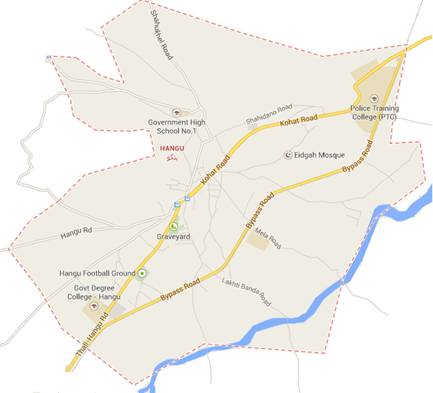
Fig. 01
Source: Google map (maps.google.co.in/)
It has two tehsils, Hangu and Thall, a town Doaba, 17 Union Councils, two Municipal Committees i.e., Hangu and Thall, and one town committee i.e., Doaba. It is 39 km away from Kohat and 102 km from Peshawar. The district is famous for its scenic beauty spots, much mineral and forests wealth. The valley is thoroughly green, charming and attractive. Samana is one of the loveliest picnic spots.
According to the census of 1998, the total population of Hangu district is 314529. It is inhabited by a number of tribes including Bangash, Orakzai, Khattaks, Afridis, Syeds, Shinwaris, Qureshis, Parachas, Mians and Niazis. Due to exodus from Orakzai Agency the Orakzais now constitute 50 % of the total population. Besides these, Afghan refugees have also contributed to the make up of Hangu population. Afghan refugees have affected the district economy by occupying some of the sources of income especially of the lower classes. Bangash is the biggest tribe. The second largest tribe is the Orakzai who entered from Orakzai Agency by purchasing land from the locals. Besides Bangash and Orakzai, other tribes are confined to few villages.
Hangu inhabitants are divided into Sunnī and Shi’a. Sunnīs are in majority and thus enjoy more economic and political power due to their heavy numeric strength. However top and good businessmen are Shi’a. Both the sects are stuck to their beliefs and follow their faith in its most conservative form. Towards the east of Hangu city, there is Shi’a dominant area, where Lodhi Khel is inhabited by Shi’as and Shahu Khel by both Sunnīs and Shi’as sects with majority of the latter. Towards the west of Hangu there is Sunnī dominant area where hardly a Shi’a lives. In main Hangu bazaar both the communities co-exist. During the sectarian strives in the Hangu city, help for the Shi’as come from the east while for the Sunnīs from the west.
Religion is seams to be the final word for both the sects . They have great regard for their respective ‘religions’. Religious emotionalism is the main characteristic of the people of both the communities. Majority of the lower class people are ignorant and are therefore, exploited by politicians, mullahs and moulvis and sectarian organisations for the fulfilment of their ulterior motives. Secondly, they are so much emotional towards their religion that they can do anything, including killing innocent people of the other sects. They find it their religious obligation to safeguard their faith and to fight against the ‘enemy’. The men on pulpit also play a leading role in building emotional attitude of the people towards their religion. They have not been just taught to live and die for the beliefs for their religion, but they are also taught to kill for someone (followers of own sect). The adherents of each sect consider themselves the only true Muslims. The followers of one sect cannot tolerate the religious ideologies of other and thus oppose each other with full vigour and violence, which leads to deaths and property damage between the sects.
Origin and Escalation of Sectarianism in Hangu
Sectarian violence between Shi’a and Sunnī sects in Hangu district is a known phenomenon for the past four decades. Hangu was a peaceful city before 1980. Both communities used to live together in harmony and helped each other in times of need and necessity. They participated in marriages and funerals of each other. One of the deputy superintendents of police (DSP) at Hangu talked about those days that ‘during my three years job at Hangu I could hardly find a person with a small knife.’ However, towards the close of 1970s some internal and external developments took place which directly and indirectly affected the Shi’a-Sunnī relations. The ‘Islamic Revolution’ in Iran, Zia’s Islamization programme and Saudi Arabia and Iran support to their ideological comrades fomented the sectarian feelings in the area. Consequently, sectarian clashes started in the early 1980s and continued in 1990s and the first decade of twenty first century. Following is a brief history of the genesis escalation of sectarian clashes in Hangu.
The Clashes of 1980
It is reported that the sectarian clash of 1980 has its origin in the local dispute between two families i.e., Khans and Maliks over the issue of possision of a Hujra situated in Khan Bari Union Council, a Sunnī dominant area. The former family was Sunnī while the latter was Shi’a. The Sunnī community used to gather in the Hujra throughout the year while the Shi’a only gathered on 9th Muharram. The structure of the Hujra was such that there was no wall around it. The Sunnīs wanted to construct a wall around it. They brought bricks and stones and started construction during night. This was resented by the Shi’a community and registered a complaint in the police station.
It was further reported that next morning 25 policemen came to the disputed place. They collected ten Shi’a and 15 Sunnī elders to solve the matter through negotiation. In the meantime, a Shi’a extremist Khadim Hussain along with 15-armed men reached the spot. He lifted the slogan of Ali and started firing. He also opened fire at police when the police stopped him. Both Sunnī and Shi’a started firing at each other. The DSP announced through mosque loudspeakers to halt the firing but both the parties did not heed to his pleas. Ultimately tear gas was used against them. When the situation deteriorated, Superintendent of Police and Deputy Commissioner called for further police along with Frontier Constabulary personnel. Now the Shi’a extremists climbed the Shah Almast Mountain and opened fire over the entire village from their trenches. As a result of this firing four Sunnīs died. Though the Sunnīs are taking care of the Hujra but the dispute is still unresolved.
The Dispute of 1988
Since Zia’s Islamization process alienated the Shi’a community, therefore on his death on 17th August 1988, the Shi’a community of Hangu committed aerial firing to express their happiness. They laid a dog in the coffin and pretending it to be Zia’s dead body, walked with it as a funeral procession. This was resented by the people of Orakzai Agency. They, therefore, entered the area and ultimately Shi’a-Sunnī clashes erupted in Shahu Khel and Lodhi Khel killing one Sunnī.
No. of FIRs |
Casualties |
Injured |
Property Losses |
Remarks |
|||
Sunnī |
Shi’a |
Sunnī |
Shi’a |
Sunnī |
Shi’a |
||
4 |
1 |
- |
- |
- |
- |
-One Suzuki pick-up. |
All the accused nominated/ |
Source: Police Department Hangu.
The Conflict of 1998
The clashes of 1998 were very severe which caused killing of many lives on both sides. These happened on Al-Quds day as well as on Nauroz day. On 23rd January 1998 when the Shi’a community was observing the Al-Quds day, Imamia Students Organization (ISO) took out a procession in main Bazaar Hangu. According to Sunnīs they were raising slogans against the companions of the Holy Prophet (SAW). Responding to these slogans Sipah-i-Sahaba Pakistan(SSP) workers also came out on the road in the form of procession. In the meantime, some unknown terrorists fired on Sipah-i-Sahaba Pakistan’s followers in Hangu Bazaar killing one Sunnī and nine injured. The Sunnīs believed that the militants were Shi’as.
The Sunnī Supreme Council of Hangu appealed for observing a strike on coming 20th and 21st March 1998. On 21st March the Shi’as had to celebrate their traditional festival Nauroz. The government therefore, deployed militia and Frontier Constabulary (F.C.) at important places and in the surrounding hills to avoid the possibility of any unpleasant event. At about 9.00 AM on 21st March, as the Nauroz procession was about to proceed from its usual starting point near Hangu College, some unidentified assailants opened indiscriminate firing on the crowd killing 10 Shi’as and injuring 25. The Shi’as believed that they were Sunnīs. Violence spread to other villages as well. In the exchange of fire, heavy weapons, including mortars, rocket launcher and missiles were used.
Clashes between the two warring sects continued for the second day, killing and injuring many more. Sporadic firing took place in several parts of the district. The district administration of Hangu managed to broker a cease-fire between the two warring sects with the help of FC and army after losing 5 more lives.
On 24th March 1998 an armed Sunnī lashkar (group) of tribesmen from the adjacent Orakzai and Khyber agencies attacked the Shahu Khel village, some 18 km away from Hangu, killing 15 Shi’as and injuring several others. The attackers used locally made-anti-aircraft guns, missiles, rocket launchers and other heavy weapons. As a result, the entire village was burnt down to ashes. In Saidano Banda village, a college student was also gunned down during night raising the toll to 31 persons. Thus clashes between the two sects continued for the fourth day.
No. of FIRs |
Casualties |
Injured |
Govt. Official Injured |
Remarks |
||
Sunnī |
Shi’a |
Sunnī |
Shi’a |
|||
4 |
5 |
21 |
26 |
48 |
4 |
All the criminal proceeding had become in effective due to peace agreement of impartial Jirga of 1998. |
Source: Police Department Hangu.
With the help of a Jirga (grand assembly)a peace agreement was signed on 27th November 1998 between the Shi’as and Sunnīs. A sum of two cror rupees was declared tegah between the two sects.
The Clashes of 2001
On 1st March 2001 an unidentified armed man, boarding a pick-up fired at Shi’a shopkeepers at 12.00 noon in Jamal Market, situated in main Bazaar Hangu killing three Shi’a shopkeepers and injuring one. This incident erupted clashes between Shi’as and Sunnīs. All Bazaars and commercial centres were closed down as a mob set ablaze many vehicles and shops at the main bus stand. Extensive firing continued between the two warring sects. In this exchange of fire, heavy and sophisticated weapons were used including mortars and rocket launchers. District administration called militia and FC and curfew was imposed in the district and orders of shoot-at-sight were given for those found violating the curfew. The curfew lasted for 70 days.
No. of FIRs |
Casualties |
Injured |
Property Losses |
Remarks |
||
Sunnī |
Shi’a |
Sunnī |
Shi’a |
|||
4 |
12 |
4 |
23 |
6 |
Rs.30 Million (Approx) |
Curfew was imposed for 70 days. |
Source: Police Department Hangu.
After March 2001 incident, government formed a Jirga. It took statements from both sides and carried out decisions on 4th July 2002. An amount of one cror rupees was fixed as a tegah between the parties.
The period between 2002-05 did not witness sectarian conflict in Hangu. The reason could be that they remembered the heavy human and capital loses in 1998 and 2001 sectarian clashes. As a result, the sectarian clashes were in dormant phase. With the passage of time, these sectarian conflicts again came to surface and in 2006 an escalation is observed in sectarian strife.
The Clashes of 2006
On 9th February 2006, a suicide bomber entered the Ashura procession and exploded in the main Hangu Bazaar at about 9.35am. This blast was followed by another blast which caused many casualties. In this incident 37 died and 91 injured. After the explosion, rioters burnt down hundreds of shops, vehicles and banks in the main bazaar and started indiscriminate firing. About 390 shops (75% shops) in the bazaar were burnt or damaged during the violence. There was heavy exchange of fire between the rival parties and sophisticated weapons including mortars and rocket launchers were used in the fire. In order to control the situation, curfew was imposed by the paramilitary and police forces. At least 100 rockets were fired from the hilltops on Ibrahimzai village, about 10 kilometres to the east of Hangu city on Friday night. Finally a ceasefire was brokered in the troubled Hangu on Saturday after three days of intense clashes between the two Muslim sects. A peace agreement was made by 24-members committee comprising elders of both sects on 12th February and an amount of Rs.20 million was fixed as a tegah.
The sectarian violence started over a dispute on a hujra in 1980 continued till the last major incident of 2006 and contributed much to the human and capital loss of both Shia and Sunni.
Factors Responsible for Sectarianism
The menace of sectarianism has its causative factors. To find a durable solution to sectarianism, it is necessary to identify the local factors followed by national and international factors. In case of sectarianism in Hangu, the following international, national and local factors have been highlighted.
Local Factors
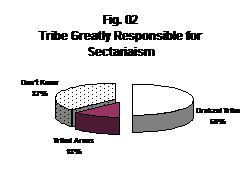
1) Orakzai and Khyber Agency
The residents of Orakzai and Khyber agencies (Tirah) are also a factor of sectarian violence in the area. The situation is further compounded by tribesmen’s love for weapons and easy availability of the arms from Dara Adam Khel. The involvement of tribesmen is evident from the clashes on 24th March 1998 in which armed lashkar of tribesmen from adjacent Orakzai and Khyber agencies attacked the Shahu Khel village using anti-aircraft guns, missiles, rocket launchers and other heavy weapons. All Shi’as and some Sunnīs testify their involvement.
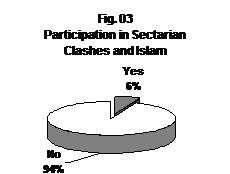
2) Fanaticism
In informal discussion with the respondents, it was found that majority of the people are religiously enthusiastic because fourth-fifth of the respondents participates in religious processions. Shi’as participates in religious processions more than Sunnīs. The element of fanaticism is also evident from the survey results which is 6% of the total respondents. This percentage is although less but it is significant in the sense that such fanatic elements ignite the fire of hatred on the eve of processions. The element of fanaticism has been measured in terms of the responses collected with regard to the question, “Is it the service of Islam to participate in sectarian clashes.”
It is due to the presence of these fanatics that provocative slogans are raised in processions which usually lead to sectarian clashes between the rival communities. Muharram ul Haram and Nauroz are the occasions for participation.
3) The Controversy of Nauroz
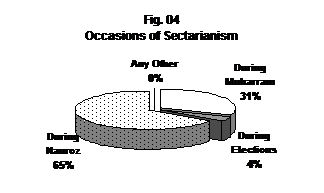
Nauroz was part of Persian / Iranian culture which is celebrated by Shi’as in Iran, Turkey, Central Asian republics, Iraq, Azerbaijan as well as Afghanistan on the starting day of each year. On this day they promise that they would start the first day of the year (based on Persian calendar) from the message of peace, love, kindness and sympathies for each other. According to the solar calendar, the day is 21st March.
In the context of Hangu, Shi’as celebrates this day because on this day Hazrat Άli was elected as a caliph. According to Sunnis, Shi’as also arranges celebrations on this day in which they dance, drink, fire and gamble. The Shias denied this allegation of the Sunnis. Nauroz started to become a bone of contention between Sunnīs and Shi’as. Sunnīs object to this festival because according to them it corrupts the minds of their youth due to dancing, drinking and gambling. Moreover, they also opined that it should be celebrated in the Shi’a dominant area only so that its impact may not spread to Sunnī areas. Sunnī-Shi’a controversy regarding Nauroz is so important that clashes of 1998 took place on the very day of Nauroz which led to human and capital losses.
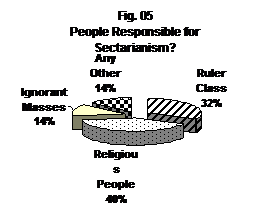
National Factors
1) Mullahism
Before explaining this factor, it is necessary to differentiate between ‘ālim and mullah keeping in view the respondents’ point of view. They regard ‘ālim as the true religious leader, broad-minded in outlook and knowing the true teachings of Islam and one who teaches peace and religious tolerance. On the other hand, mullah was regarded as semi-literate narrow-minded called religious leaders who influence people towards extremism in every aspect of life including the killing of the believers of the same religion.
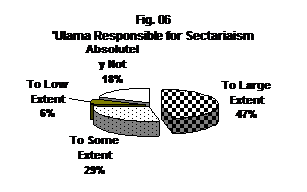 In the case of Hangu, Mullahism has also become a factor of sectarianism. It was found that a large number of people hold mullahs responsible for sectarian hatred. Mullahs from both sides actively play role in fanning sectarian hatred among the people. They are poisoning the people against each other by using loudspeakers in mosques and by issuing religious verdicts. They have found religious verdicts as good tools for declaring each other as kāfir (infidel). The Friday sermon is rich in inflammatory tone and content. During sectarian riots, they announce through loudspeakers to participate in the strives as holy obligation. They term such strives as jihād (holy war) and an easy way for getting place in Heaven. They deceive ignorant people in the name of jihād and malign the true image of Islam.
In the case of Hangu, Mullahism has also become a factor of sectarianism. It was found that a large number of people hold mullahs responsible for sectarian hatred. Mullahs from both sides actively play role in fanning sectarian hatred among the people. They are poisoning the people against each other by using loudspeakers in mosques and by issuing religious verdicts. They have found religious verdicts as good tools for declaring each other as kāfir (infidel). The Friday sermon is rich in inflammatory tone and content. During sectarian riots, they announce through loudspeakers to participate in the strives as holy obligation. They term such strives as jihād (holy war) and an easy way for getting place in Heaven. They deceive ignorant people in the name of jihād and malign the true image of Islam.
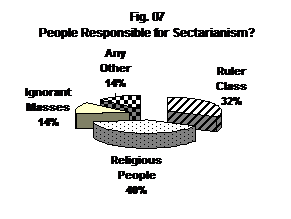
2) Political Leaders
Political leaders have not taken the problem seriously. Majority of the people complained that politicians did not play any active role in solving the problem. By manipulating this problem, they have diverted public attention from the fallacies of their politician’s lack of work and policies for uplift projects in Hangu. Secondly, they do not focus on the problem because only the common people are becoming its victims and no political leader has ever been killed or injured yet. The survey results show that so far they have not done positively to eradicate the evil. Figure 05 portrays the manipulation of the problem by the local politicians.
3) Zia’s Islamization
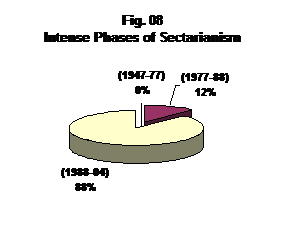
The Zia’s Islamization programme is one of the factors responsible for the growth of sectarianism in Pakistan in general and Hangu in particular. Since his Islamization programme was based on Hanafī school of thought, it alienated the Shi’a community. The process of Islamization was resented by the local Shi’as. The immediate result of this development was that it led to the emergence of the first sectarian clash in 1980 between Shi’as and Sunnīs. The local Shi’as had so much hatred for Zia that when he died, the local Shi’as celebrated the occasion with aerial firing to express their pleasure in 1988 followed by sectarian clashes. The survey results show that the phase (1988-04) witnessed a tremendous sectarian violence in the district.
4) Administration Negligence
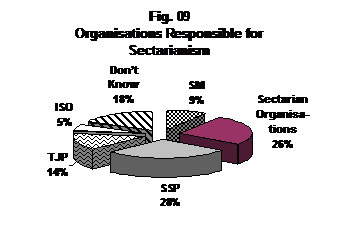
Government is said to have no interest in solving the issue. It is not taking measures which can ensure long-term peace and tranquility in the area. The performance of government functionaries, even in anticipated situations, presents a dismal picture. They intervene when blood has been shed and hatreds are intensified. There is no comprehensive national policy to curb this menace. There is a tendency to go for ad hoc and temporary solutions such as cease-fire and imposition of curfew but nothing is done on sustainable bases to build confidence and peace between the two communities. When Nauroz comes near, the administration becomes serious; when the festival is over, the government forgets about it. The weakness of government is also clear from the fact that people of both sects are using heavy weapons against each other including mortars, rocket launchers, aircraft guns and missiles etc and the administration is doing nothing to take proper action in this regard. The law and order situation is so volatile that every time the clashes are started by unknown terrorists and the government neither arrested them nor safeguarded the people from facing such terrorist acts in future.
5) Shi’a-Sunnī Sectarian Organizations
Sipah-i-Sahaba Pakistan (SSP), Sipah-i-Muhammad (SM) and Imamia Students Organization (ISO) are the dominant sectarian organizations operating in the area. The SSP is a Sunnī extremist organization while the other two are Shi’a extremist organizations. Many times sectarian strives took place in the area because of these rival groups. The event of 1998 can be quoted in this regard, in which the provocative slogans of ISO and SSP on Al-Quds day led to the Shi’a-Sunnī clashes in the main Bazaar Hangu. These extremist organizations pursue the local ignorant people for sectarian killing as their religious obligation and a source of going to Heaven. Tehreek-e-Jafaria Pakistan (TJP) has also been pointed out by the respondents, however, it is a religio-political party which is not militant in nature. The informal discussion highlighted that by TJP the respondents meant the Shiah militant organisations.
International Factors
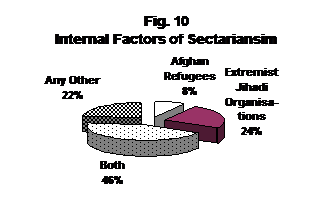
1) Afghan Refugees
Afghan refugees are one of the factors responsible for sectarianism. They have been trained in warfare against former USSR as well as in civil war of Tālibān with Northern Alliance. When they migrated to Pakistan, they knew nothing except warfare. They, therefore, merged with the extremist organizations of Pakistan and started taking part in sectarian strives. In the context of Hangu, the Afghans have been on the front lines in igniting and worsening the sectarian problem due to the proximity of Afghanistan boarder with Hangu as well as the presence of Afghan refugees in the area. The past sectarian clashes also show that many times they attacked the area with the help of heavy weapons in support of the Sunnīs.
Moreover, Afghan refugees are the beneficiaries of Shi’a-Sunnī riots of Hangu. During riots when both communities are engaged in sectarian riots, they start plundering the shops irrespective of which sect owns these shops. The previous unidentified militants’ attacks in the bazaar that led to sectarian strife also make local Afghan people suspicious due to their vested interests. The local peoples especially the labour class; also complain about the socio-economic impact that has been caused by Afghan refugees in the district. Majority of vendors on footpath and wheelbarrow are Afghan refugees. The local labour class also holds the Afghan refugees responsible for local unemployment as Afghan refugees have occupied their sources of income. The respondents confirmed that the on one side they participate in sectarian clashes for the Sunnis and on other hand they plunder the local shops after the eruption of sectarian conflicts.
2) Tālibān of Afghanistan
The Tālibān of Afghanistan have been directly involved in fanning sectarianism in the district of Hangu The then government’s pro-Tālibān policy in 1990s is also responsible for the local clashes. They directly participated in the sectarian strives in Hangu on the side of the Sunnīs and against Shi’as. The pre-planned attack of 28th March 1998 over the houses of Shahu Khel, a village of Hangu bordering on the Orakzai agency and consisting mixed population of Sunnīs and Shi’as, is proof of their involvement. During the firing they used heavy weapons like mortars, rocket launchers and missiles which burnt down the village to ashes. The local people recognised them as Tālibān of madrasahs in Afghanistan due to their appearances. They had long curly hair, long beards, wearing long shirts and speaking Persian and Pashto. It was due to Tālibān that sectarianism intensified in the major portion of the phase of 1988-2004 up to the decline of Tālibān in Afghanistan.
3) ‘Islamic Revolution’ 1979 in Iran
‘Islamic Revolution’ in Iran is one of the leading external factors responsible for the radicalization of Shi’as in Pakistan. This revolution created a sort of energy in the Shi’a community of Pakistan. The literature and messages of Imam Khomeini were circulated extensively. In Hangu, it also affected the Shi’a-Sunnī long existing cordial relations. It gave a psychological boost to the local Shi’as. It was due to this reason that after the passage of one year of the Islamic Revolution in Iran, sectarian riots took place in this area on the nominal issue of Hujra was the start of Shi’a-Sunnī riots; because it was actually a dispute between two families which later on took the shape of Shi’a-Sunnī riots. All Sunnīs and a few Shi’as also blamed Iran for providing financial aid to the Shi’a’s extremist organisations.
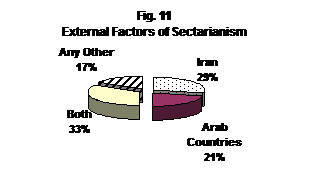 4) Foreign Agencies
4) Foreign Agencies
The foreign agencies of countries like Iraq, Saudi Arabia and Iran are also reported to be responsible for the escalation of sectarianism in Hangu. These countries helped their respective communities for the development of their state religions. Iran is backing the Shi’a extremist organisations like Sipah-i-Muhammad and Imamia Students Organisation in the area while Sunnī extremist organisation like Sipah-i- Sahaba Pakistan is backed by Saudi Arabia. The former statement has been agreed by all the Sunnīs and a few of the Shi’as while the latter statement has been approved by many Shi’as and a few of Sunnīs. It is concluded that majority of the respondents accept the involvement of both the countries.
Implications
All these causes of sectarianism have affected the social set up in the district of Hangu. Its implications have reached deep in the social and political structure. A polarized social structure can be observed based on Sunnī and Shi’a cleavages. Following are the implications of sectarianism in district Hangu.
Firstly, it has deprived many people of the low-income class from their properties. The poor law and order situation compels the people to sell their lands and buy weapons in order to ensure their family’s protection. Many people of low-income group wept over the lack of their own houses, which they had in the past. Whenever, the respondents of low-income class had to enter the source of income in a questionnaire, they wrote ‘house sold’. Some of the respondents reminded their deceased, whom they had lost in these sectarian clashes.
Secondly, apparently there seems to be harmony between the Sunnīs and the Shi’as. However, it is not so because the survey results show that the sectarian hatred has reached deep in the minds and hearts of the people. In a gathering of Shi’as, the Sunnīs are criticised and vice versa. However, in mixed gatherings members of both sects keep their biases to themselves. Survey shows that they rely on each other. However, the informal discussions with each community respondents show that they do not rely on each other. They participate in each others’ ceremonies of grief but rarely share each others’ joys. The Shi’a customers try to buy their goods from Shi’a shopkeepers and the Sunnīs try to deal in with the Sunnīs. The high ups of the district also try to support their own community. Thus the concept of sectarian division has deeply penetrated into the social and political structure.
Thirdly, the fear of being killed or hurt by terrorists is also there in Hangu bazaar. The shopkeepers close their shops in the noon and reopen them after noon in summer to avoid any unpleasant event. Similarly, before or soon after the Āzān of Maghrib (call for prayer soon after sunset) the people close their shops. Only the restaurants, the bread bakers’ shops and some of the shops of those who are living in city, are open. The fear is so much in the bazaar that a cracker blast can lead to a communal clash. Fourthly, women are so uncertain about peace in the bazaar that they hardly visit it.
Suggestions
Hangu is newly sectarian hit place as compared to Parachinar, Karachi and certain districts in Punjab. It has badly affected the socio-economic life in the district. In order to curb sectarianism in Hangu and other parts of the province, there is a need to take some steps by all stake holders. Suggestions can be categorized as; long term measures, short term and local administrative measures.
Long-Term Measures
Religious Tolerance
Freedom of expression is the right of every person. However, no one should impose his own opinion on others. An argumentative approach should be adopted towards others rather than conflictive. The imposition of one’s opinion over others creates antipathy and vanish the feelings of brotherhood and sympathy. It leads to the social segregation on the basis of sectarian adherence. In such a situation the possibility of a sustainable peace becomes difficult. For the maintenance of a lasting peace and tranquillity in the society, it is obligatory to observe the principle of right of expression and respect to others opinions. The theme of tolerance should be incorporated in the school curriculum as well as manifested in the co-curricular activities of the students.
Non-Sectarian Council of ‘Ulama
The sectarian identity of the people is due to the sectarian ideology taught by the mullah and ‘Ulama of their respective sects. This ideology widens the gap between the people of various sects. Resultantly, the followers of every sect consider themselves the only true Muslim in the world. They have been taught in such a way that they feel proud of the sect they belong to and consider other sect as batil (not on right track).
The ‘Ulama in Hangu are influential in the sense that people hold them in great esteem. They should discourage such ideology and uphold inclusivism in their daily sermons. This would be automatically followed by unity among the masses. It is possible if ‘Ulama constitute a council consisting of the ‘Ulama of all the sects. This common platform of ‘Ulama will affect the attitude of the masses so far as respect to other sects is concerned. It would also provide a common platform for solving various sectarian problems through various consultations.
Religious Awareness
Majority of the masses are unacquainted about the true teachings of Islam. The ignorance of the masses is exploited by the mullahs. Masses of the opposite sects are killing each other in sectarian strives and term it as Jihād. Awareness should be created among the masses regarding the true teachings of Islam. This can be effectively done if the ‘alim of every sect takes responsibility of conveying true Islam to the advocates of the concerned sects. Narrow interpretation of Islam should be strongly discouraged. The true concept of jihād should be highlighted. Suicide attacks should be condemned. Respect for human beings and punishment for killing of a human should be implemented. Books and pamphlets should be published to discourage sectarian killing. Live programmes should be telecast and broadcast for the promotion of unity.
Elimination of Unemployment and Poverty
Majority of the terrorist activities are carried out by the people of poor class. Some of them accept this choice due to unemployment and poverty. Having nothing to do, these people can be bought easily for carrying out terrorist activities. Steps should be taken by government for elimination of unemployment and poverty. Employment will not only decrease intensity of poverty but it will also keep people busy and thus away from sectarian violence. It also eradicates the sense of envy. Government should create equal job opportunities so that poor and deprived people may earn their livelihood through legal means. It should also launch welfare projects for elimination of poverty. Beside social uplift, these projects will also provide job opportunities to the jobless.
The Role of NGO’s
Non-governmental organisations should be encouraged to set up in each sectarian hit place. Its staff should consist of local religious people of all the local prevailing sects. The collective work of NGO’s staff members will not only create a sectarian harmony within NGO but also in the locality where it exists. It will also provide a common forum for solving sectarian issues. Inclusion of ‘Ulama in the staff of NGOs will also eliminate general apprehension which ‘Ulama and masses have regarding the negative role of NGO’s.
Short-Term Measures
Ban on Sectarian Speeches and Gatherings
Sectarian speeches are delivered by the mullahs from the loudspeakers of their respective mosques as well as by the leaders of the sectarian organizations from the forums of their respective organizations. These speeches motivate the ignorant masses particularly the young ones for fighting for the cause of their sect as their foremost religious obligation.
Similarly, sectarian gatherings increase religious fanaticism because it is in these gatherings that more emphasis is made on adherence to a sect. The sectarian leaders on such occasion also demand more and more loyalty from its followers for the propagation and protection of their sectarian ideology. It is on such occasions that bombs are blasted.
A strong embargo should be levied by the government so far as delivering of sectarian speeches and sectarian gatherings are concerned. The local administration in a sectarian ridden place should strictly implement various laws in this connection and those who violate them should be brought before justice.
Ban on Sectarian Organisations
All the sectarian groups and parties fanning sectarian hatred should be banned. Their offices should be sealed. Their workers and leaders should be put behind bars. Though this practice is against the notion of freedom of association and expression, but it is essential for maintaining public peace and order. However, this imposition of ban should not be extended to peaceful groups who are in no way involved in fanning fanaticism.
Ban on Arms and Ammunition
Due to the proximity with the tribal areas, the tribesmen’s trigger-happy temperament can be seen in Hangu. This situation is further compounded by the easy availability of weapons from the tribal areas. Similarly, sectarian organisations are reported to have heavy weapons through which they carry out their militant activities. In sectarian clashes these arms are used against the opponent in a more violent form.
The government should impose a ban on the mobility of the weapons. Arms without license should be seized and the offenders should be punished severely. Great care should be taken while issuing arms license. Those involved in illegal selling, buying and trafficking of arms should be severely dealt with.
Effective Law and Order Situation
Poor law and order situation is the main threat to life and properly. It provides an easy opportunity to the assailants for conducting their terrorist activities. The 1998 and 2001 sectarian clashes took place in Hangu due to the poor law and order situation. The law and order situation is therefore needed to be revived and improved. The efficiency of the law enforcing agencies should be increased. The number of policemen should be increased. They should be trained along the modern lines. They should be equipped with modern and heavy weapons so that no one has the dare to disturb the social peace. The local influential mullahs and politicians should whole heartedly cooperate in this connection.
Ban on Publishing Sectarian Literature
The sectarian organisations publish their sectarian literature for the protection and propagation of sectarian ideologies. The literature is mainly composed of articles regarding sectarian issues which have been discussed in a provocative manner. Various pamphlets are distributed among masses for creating alienation against the rival sect.
For sectarian harmony, a ban should be imposed by the government on composing, publishing and distributing sectarian literature. Violators should be put behind bars and subjected to severe punishment. In addition, efforts should be made by the ‘Ulama of all sects to produce literature which contributes to cordial relations among various sects. The common masses should also avoid reading literature of sectarian nature. This collective struggle of government, ‘Ulama and masses will fully discourage publication and distribution of sectarian literature.
Local Administrative Measures
Deployment of Frontier Corps on Orakzai-Hangu Border
Orakzai Agency is situated to the north of Hangu. Orakzai tribesmen had entered Hangu by procuring land from the Hangu residents. Now it constitutes the second largest tribe in the area. During sectarian clashes, Orakzai tribesmen intervene in Hangu and fight for the local Sunnī cause. It increases not only the intensity of the sectarian strive but also lengthens its duration because heavy and sophisticated weapons are used in this fight.
In order to halt the intervention of the Orakzai tribesmen in Hangu, there is need of deploying frontier corps along the Orakzai-Hangu border. The presence of FC would reduce the aggression from Orakzai side.
Celebration of Nauroz
Nauroz should be celebrated in the Shi’a dominant area rather than in the areas where only Sunnīs or both the communities exist. Since majority of Hangu residents are religious fanatics, therefore, hurdles may be created by the ignorant and fanatic masses in the celebration of Nauroz. Consequently, it is in the best interests of both the communities if Nauroz celebration is held in Shi’a majority area. It will also abolish the chance of criticizing Nauroz by the Sunnīs.
Secondly, the Shi’as should celebrate the Nauroz in its actual spirit so that to fulfil its very purpose for which the Persians and Afghan used to celebrate it. Its purpose is to start the first day of the year (based on Persian calendar) from the message of peace, love, kindness and sympathies for each other. But in case of Hangu it contributes to the loss of lives and properties on both sides. This is due to some of the controversial activities carried out on the eve of Nauroz. e. g. dance, gambling, firing, drinking. The Shi’a community should therefore avoid the observance of such activities in Nauroz which are repugnant to Islam.
Covering of Hilltops
After the sectarian disturbances in Hangu, it has been seen that the rival parties try to be first in covering the hilltops of the town. The mountains of the town, has many trenches which are highly suitable for firing at down villages. For example in the sectarian clash of 2006, about 100 rockets were fired at villages down to the mountains. During such clashes, the national forces should first cover these hilltops so that to stop the rioters from further deterioration. Secondly, during the entire month of Muharram, the national forces should permanently cover the hilltops and other key locations so that to make the combatants unable to occupy these strategic locations. This would certainly avoid the chances of the happenings an unpleasant event in the district.
Conclusion
Hangu, like other sectarian-ridden places, too has suffered from the menace of sectarianism. Hangu has witnessed many sectarian strives including the sectarian clash of 1988, 1998, 2001 and 2006. There are many local, national and international factors that have contributed in escalating the sectarian violence in Hangu. The local factors include the fanaticism of the tribesmen particular those belonging to Orakzai Agency, the celebration of Nauroz and the ‘Ashura procession. The national factors Zia’s Islamization, administrative negligence, Mullahism, Sunni-Shia sectarian organisations and militant madrasahs. The international factors are ‘Islamic Revolution’ in Iran, Taliban of Afghanistan and foreign agencies. In order to contain the issue, various local-based, short-term and long-term measures have being suggested. In terms of local-based measures, it has been recommended to deploy FC on Orakzai-Hangu border, celebrate Nauroz in Shia dominant area and covering of the hilltops in Hangu by national force. Regarding the short-term measures, it has been proposed to impose ban on sectarian speeches and gatherings, ban on sectarian organisations, ban on arms and ammunition and ban on publishing and circulating sectarian literature. Referring to the long-term measures, it has been suggested to adopt a tolerant religious attitude, create religious awareness, eliminate unemployment and poverty, establish non-sectarian council of Ulama and mobilize NGOs for playing their positive role. All these measures will reduce the intensity of the issue of sectarianism in Hangu to a greater extent.
Bibliography
Unpublished Thesis
Orakzai, Nasir Mehmood Khan.,[2001-03]: Hangu, Land and People,unpublished Masters Thesis, Pakistan Study Centre, University of Peshawar, Peshawar
Unpublished Reports
A Statistical Snapshot of Sectarian Clashes in Hangu, Police Department, District Hangu.
FIR No. 220 Dated. 18-07-1980, Police Station Hangu.
Jirga Decision, November 27, 1998
Jirga Decision, July 4, 2001.
Police Department Hangu Reports.
Books
Enayat, Hamid., [2005]: Modern Islamic Political Thought. I.B. Tauris & Co Ltd, New York.
Newspapers and Magazines
Daily Dawn, Karachi (February 11, 2006).
Daily Dawn, Karachi (February 12, 2006).
Daily Dawn, Karachi (March 2, 2001).
Daily Dawn, Karachi (March 22, 1998).
Daily Dawn, Karachi (March 23, 1998).
Daily Dawn, Karachi (March 25, 1998).
Daily Dawn, Karachi (March 29, 1998).
Daily Mashriq, Peshawar (March, 21, 1998).
Daily The News, Islamabad (May 6, 2003).
The Scenario, Islamabad (May 1998).
The Sunday Guardian (May 5, 2014), http://www.sunday-guardian.com/analysis/zias-tenure-fragmented-pak-society (Accessed on 05/05/2014)
Interviews
Interview with Saboor Khan, (Journalist of Daily Dawn) Hangu, May 25, 2004.
Interview with Shafiquallah Khan, Assistant Professor, University of Peshawar (a resident of Hangu) Peshawar, May 28, 2014.
* Professor, Department of Political Science, University of Peshawar.
** Lecturer, Department of Islamic/Pakistan Studies, the University of Agriculture, Peshawar.
A place between Madina and Makkah. The Shia referred to the saying of the Prophet, “He for whom I was the master, should nence have Ali as his master”.
Lodhi, M., Zia’s Tenure Fragmented Pak Society. In The Sunday Guardian, May 5, 2014. Retrieved from http://www.sunday-guardian.com/analysis/zias-tenure-fragmented-pak-society, accessed on 05/05/2014
Orakzai, N. M. K., Hangu, Land and People,unpublished Masters Thesis, Pakistan Study Centre, University of Peshawar, Peshawar 2001-03, pp. 1-2.
Khans and Maliks belong to this tribe. The Khans, Maliks and the Syeds are claiming the ownership of Hangu.
A common place for guests in Khyber Pakhtunkhwa villages. It also serves as place to get together in sorrowful and joyful events.
A Statistical Snapshot of Sectarian Clashes in Hangu, (Unpublished), Police Department, District Hangu.
Literally means the holy day. Shi’as observe the last Friday of Ramazān (fasting month) as al-Quds Day.The day has been fixed by Imam Khomeini for arranging rallies and seminars after Friday congregation in order to show support for Palestinian cause.
Literally means ‘New Day’. Nauroz was part of Persian culture which the Persians celebrate on the starting day of each year. On this day they promise that they would start the first day of the year (based on Persian calendar) from the message of peace, love, kindness and sympathies for each other. According to the solar calendar, the day is 21st March. In the context of Hangu, Shi’as celebrates this day because it coincided with day when Hazrat Άli proclaimed Khilafat. According to Sunnis, Shi’as also arranges celebrations on this day in which they dance, drink, fire and gamble.
Imamia Students Organization is a Shi’a organization formed on May 22, 1972 at the University of Engineering and Technology in Lahore and its founders included Dr. Majid Naroze Abidi and Ali Raza Naqvi. Dr. Marghoob Zaidi became its first president. Purpose of the organization is to protect the interests of, and provide financial support to, Shi’a students all over Pakistan. By 1977, ISO had proliferated all over the country and had developed contacts with a number of similar organisations in Iran. This relation became further strong with the ‘Islamic Revolution’ in Iran in 1979. ISO has played an active role in protesting against the Islamization process of Zia regime.
Sipah-i-Sahaba Pakistan is one of the major anti-Shi’a splinter group in Pakistan. On September 6, 1985, Maulana Haq Nawaz Jhangvi, a Deobandī ‘alim of JUI (F) founded Anjuman-i-Sipah-i-Sahaba Pakistan in Jhang, later renamed it as Sipah-i-Sahaba Pakistan. It was the first organized Sunnī party with the exclusive professed objective to defend the honour of Sahāba (companions of the Holy Prophet (SAW)) and counter and contain the influence of ‘Islamic Revolution’ of Iran in Pakistan.
Literally means stone. A tradition among the tribesmen in which the two warring tribes temporarily agree for cease-fire.